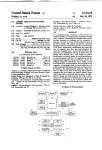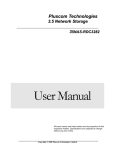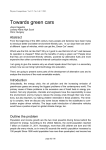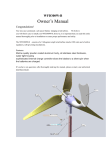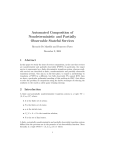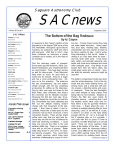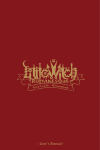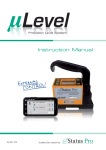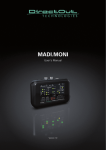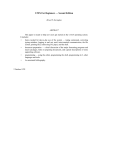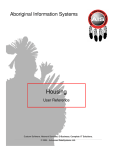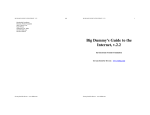Download Tree of Life FINAL.indd
Transcript
Planting Your New Tree of Life A Ritual of Personal Transformation by Brandt Morgan copyright ©2005 Brandt Morgan Planting Your New Tree of Life A Ritual of Personal Transformation by Brandt Morgan E-book design & layout: Peggy Raes, raes[email protected] copyright ©2005 Brandt Morgan It may be that some small root of the sacred tree still lives. Nourish it, then, that it may leaf and loom and fill with singing bids. — Black Elk, Chief of the Oglala Sioux ©2005 Brandt Morgan Preface Among the native peoples of North America—in fact, among indigenous peoples all over the world—there is an ancient tradition called the vision quest. This is a period when a young person goes out into nature to fast and pray for a vision that will reveal his or her gifts and place in the tribe. Vision quests are very much like works of art: they come as revelations even to their creators. I did my first one in the Pine Barrens of New Jersey in the fall of 1983 under the direction of my teacher, Tom Brown, Jr., who had learned the ritual from his mentor, an old Lipan Apache scout named Stalking Wolf. Surrounded by scrub oaks and pines, I fasted, meditated, prayed, and danced barefoot around a ten-foot circle for four days and nights. By the afternoon of the second day, my feet had worn a clear path into the sandy soil, revealing a mound of dirt with a single, small oak tree in the center. As I danced, I chanted and prayed, sending all my love and energy to the central mound without really knowing why. Throughout the day, I was amazed to find that my feet were throwing off wonderful spiral patterns in the sand. I danced most of the second night. When the sun rose on the morning of the third day, I was astonished at what I saw. Before me the new light revealed a marvelous, spinning galaxy, its sweeping arms reaching out into a forest universe. In the center of the galaxy, now clearly defined by the path encircling it, was the earth itself. And growing from the very center of the earth was a little oak tree, a symbol of the universal Tree of Life. In awe I knelt down and reached into the center of the sandy “galaxy” I had so lovingly created during the night. It was completely clear except for a tiny root from the central tree that seemed to be reaching into the stars like an eager tendril. I was eecially struck by the fragility of the root. I knew that it represented something very important and precious 1 ©2005 Brandt Morgan within me, something I had never consciously known but that had the power to change my entire life. During the remainder of my quest, whenever I came around to that little root, I stepped very carefully. To break it would have broken my heart. I didn’t fully understand the meaning of my vision that morning, or for many mornings afterward. In fact, it continues to grow in me even now. But I felt it profoundly. When I walked out of the Pine Barrens on the morning of the fifth day, I knew deep inside that my life was about finding my roots to the earth and nourishing the Tree of Life within me. I also knew that part of my job was to search for the roots beyond belief: the truth of what I am, the truth of what we all are, and the truth of what we are doing here on this misty lue marle spinning on the edge of a spiral galaxy in empty space. More than that, I knew that my greatest joy in life would come through sharing the truths I discovered. For me, this book is a part of that joy. In the years since my first vision quest, I have gone many places and done many things. Today, much of what I do is encourage others to strip off their false masks and live their deepest truth. Most of the people who come to me are dissatisfied with their lives. Some have relationship prolems and money issues. Some are chronically depressed or addicted to negative thought patterns. Some suffer from low self-esteem and selfsabotage. Others are fairly happy but sense that there must be something more to life. Over the years, I have offered these people a variety of tools they can use to discover who they are, why they are here, and how to realize their greatest dreams. This book is a user’s manual for one of those tools—a ritual called Planting Your New Tree of Life. The Tree of Life is an ancient symbol with deep meaning, rooted at the core of cultural and religious traditions all over the world. It is the symbol of life in harmony with the seasons, the cosmos, and the Creator. I use the Native American Tree of Life as my point of departure because that is the one in which my own vision is rooted. Over the years, my understanding and appreciation for the Tree of Life has been nourished and deepened 2 ©2005 Brandt Morgan by friends and teachers from many tribes—most notaly Puelo, Hopi, Arapaho, Seneca, Chiricahua and White Mountain Apache, Cheyenne, Lakota, and Lenai-Lenape. Even today, most tribes perform dances or other sacred rituals honoring the seasons, calling on the Creator for lessings and aligning themselves with the forces of nature. Each tribal member, from the tiniest infant to the wisest elder, becomes part of this living expression of harmony and gratitude. One of the most powerful of all aboriginal ceremonies is the Native American Sundance, a summer ritual in which participants offer their own life energies as gifts to the Tree of Life. At sunrise, dancers dressed in colorful kilts file through a circular arbor into the open dance grounds. As the big drum begins booming out its rhythm to the south and the air fills with high-pitched song and the wafting smells of sage and cedar, the dancers begin lifting and planting their feet. Periodically raising their hands to honor the rising sun, the four directions, and the Great Tree of Life, they dance for hours at a stretch sometimes, and some of them go four days without food or water. The tree—usually a sixty-foot aen or cottonwood that has been cut from the forest and sunk deep into the earth—stands in the center of the circle as a warrior and living axis mundi, its leafy branches festooned with colorful streamers and dangling leather fertility symbols. For four days, the dancers bake in the hot sun, pouring out their love and prayers to the tree. The entire area is transformed into a huge, living expression of the sacred pipe sending prayers to the Creator: the tree becomes the pipestem, the dance grounds become the bowl, and the dancers become the burning tobacco. Magic happens on this ritual stage of nature. Eagles soar in from the mountains to the east. Dark clouds sail in from the plains to the west. Gophers pop their heads up in the middle of the dance grounds. Thunderbolts and pelting rain add their dramatic applause. But the most powerful transformation happens silently and unseen. Gradually, 3 ©2005 Brandt Morgan bound through hours of lood, sweat, and tears, the dancers fuse into one passionately beating heart. Through sheer devotion in aion, the people merge with the Tree of Life. The tree becomes a place of death and rebirth, the passageway to a fresh expression of truth and flourishing new life. When the Sundance is over, something fundamental has changed in the heart of the tribe. It is more unified, more grounded, more aligned with the earth, sun, and stars. The Tree of Life now lives within the tribe. The tribe has become the tree, and the tree has become the tribe. The same is true of Planting Your New Tree of Life. When it is over, something fundamental has changed in you. That change begins when you sit down to take stock of your life. It continues as you go “into the woods” to choose a tree that represents your authentic self. It deepens as you make your tree into a living altar and perform the ritual. It is completed as you release your false self to the truth of who you really are. Like a dancer in a Sundance circle, gradually you become the tree. On the surface, the ritual of Planting Your New Tree of Life is very simple, yet it is extremely powerful. It works because it bypasses the mind, the part of us that wants to control and complicate everything. It works because it dives beyond the ego’s need to protect and defend. It works because it shatters the old habit patterns that say we’re bad or not good enough. It goes straight to the heart, the part of us that knows and supports the truth of who we are. And there it reveals the one small root that can make our Tree of Life leaf and loom and fill with singing birds. “What difference will it make in my life?” you may ask. The results of the ritual are as varied as those who perform it. Those who do it with sincerity immediately feel more hopeful and joyful. They report having a new lease on life, as though they had found a precious jewel within themselves they had completely forgotten. They begin to think new thoughts, eak new words, make new choices, take new aions. Day by day, their new thoughts, words, and deeds feed their new Tree of Life, and soon it bears new fruit. That fruit is as different and unpredictale as each individual. 4 ©2005 Brandt Morgan To bring this down to earth, let me give you an example: Before my friend Bill did this ritual, he was apologetic for being. He was 120 pounds overweight. He had been through a string of failed relationships. He was a perfectionist. Nothing and no one was ever good enough for him, least of all himself. He was intensely frustrated by his inability to make decisions. For seven years he had been working as a computer technician, a job he disliked intensely but was reluctant to leave for fear of disappointing his boss and co-workers. For more than a decade, he had dreamed about starting his own hydroponic gardening business, but he was afraid of doing that, too. He was almost completely immobile, equally afraid both of failing and succeeding. After years of therapy, still mired in mediocrity and self-doubt, he came to me in near despair and asked, “What can I do?” I told Bill about the ritual. I told him it was so simple he probaly would not believe it but that it was not necessary for him to believe anything. Figuring he had nothing to lose, he took my word for it. After listening to my instructions, he quickly took all the necessary steps and planted a new Tree of Life the very next day. A few days later, Bill quit his job and booked a flight to Tucson for a week-long hydroponic gardening seminar. The day after that, he joined a gym and began regular workouts. With a rapidly growing sense of joy and self-esteem, he began to eat less and exercise more. Between his workouts and his new diet, he lost forty pounds the first month. A month after that, he called to report that he was in love without fear for the first time. Then almost two months passed, during which I didn’t hear from him at all. So I called to see how he was doing. “How are you doing, Bill?” I asked. Our conversation was long and far ranging. In a nutshell, though, what Bill said was this: “I don’t have much time to talk about how I’m doing anymore, because I’m too busy doing it. I don’t have time for therapy anymore because I’m too busy living. I don’t have room for self-doubt because I’m too full of self-love. My personal trainer at the gym says I’m 5 ©2005 Brandt Morgan in the zone, but the truth is, I’m on fire. Thank you so much!” Bill needn’t have thanked me. He was the one who did the ritual and followed through on it. So can you. Bill’s experience was quick and dramatic. It might even seem too good to be true, but it happened. The ritual itself was a crossroads, a choice point, a declaration to the universe inviting dramatic change. Bill performed an act of power that opened the door to a whole new way of life. After planting his new Tree of Life, he then faced the even greater challenge of nourishing it—of persevering and paying attention, of watering and weeding, of making sure his tree was getting enough light, growing free of parasites and constricting vines. Because he took these aions, his tree lossomed and filled with singing birds. Bill was not ecial. If he did it, you can do it. With courage and perseverance, anyone can do it. Now I invite you to read on and experience the flowering of transformation in your own life. 6 ©2005 Brandt Morgan How to use this book This book includes five chapters. Each of the first four chapters focuses on one simple thing you need to do, either to prepare for the planting of your new tree, to perform the ritual itself, or to nourish the tree after planting it. In Chapter 1, By Their Fruits, you will look at the branches, twigs, leaves, and fruits of your current Tree of Life and identify the primary root, or core belief, that is feeding it. In Chapter 2, New Roots, you will envision a new Tree of Life—the life you want to be living—and then decide what seed, what new root or core belief, would naturally create such a tree. In Chapter 3, The Planting, you will learn how to design and perform your own unique “tree-planting” ritual of transformation. In Chapter 4, Nourishing the Tree, you will learn how to pay attention to and care for your new Tree of Life until it is consistently bearing the kind of fruit you want. Finally, in Chapter 5, New Leaves, New Lives, you will read inspirational stories that will give you new ideas for your own tree planting and for living from your authentic self. This book is intended as a workbook. It includes lots of aivities aimed at initiating change on many levels. The more involved you become with it, the more dramatic and lasting these changes will be. For this reason, I encourage you to make the book your own. First skim it from cover to cover so you get a feel for the process, then come back and follow the instructions in each chapter. As you do the exercises and aivities in the book, relax and make friends with it. Dog-ear the pages, scrible in it, spill coffee on it, take it home to meet your parents. Have fun with it. The more you enjoy it, the more deeply it will affect you. Among the aivities in this book are several meditations. For best 7 ©2005 Brandt Morgan results, record these and play them back to yourself, or get somebody to read them to you in a soothing voice. Chapters 1 and 2 include a wide variety of questions about your life. I suggest that you write the answers to some or all of these questions directly in the book. Again, this is a workbook. Its main job is to help you discover who you are and how to live your own life. It can only do this if you get involved with it. The more involved you become, the more effective the process will be. In some chapters, you will find Tree of Life Work Pages for jotting down thoughts and ideas. There are also Tree of Life Journal Pages provided at the back of the book for you to monitor your daily thoughts and aivities after doing the ritual. When you are done, all these jottings and scriblings will be left as powerful reminders and inspiration for continued aion. It will not take long for you to examine your tree and identify the core belief that is feeding it. Nor will it take long for you to decide what new root would bring peace, love, joy, and abundance into your life. The ritual itself can take as much or as little time as you choose. However, after you have skimmed the book, I suggest you set aside at least a full day—better yet an entire weekend—to focus on the ritual and nothing else. As with all rituals, much of the power is in the preparation. Like a gardener tilling hard soil before planting a seed, you are preparing your mind to receive a new thought—a thought that may not take root easily after years of hardened habit. Set aside all the time you think you will need plus a little more. Your efforts are much more likely to bear fruit if you are not distraed or preoccupied with time. Of course, the ritual itself is only the beginning. Once you have planted your new tree, nourishing it will become an ongoing aivity. This will require daily attention until the tree is strong enough to stand on its own. But day by day, as you taste the delicious fruits of your efforts, that aivity will quickly become a habit. And soon that habit will become a joy. 8 ©2005 Brandt Morgan Chapter 1 By their fruits To native North Americans, the Tree of Life represents the bounty of the earth and the lessings of the Creator that combine to produce harmony, happiness, and abundance for the tribe. Ultimately, though, all life is one. The same life force that expresses through a tribe expresses through a cat, a nation, or a lade of grass; it just expresses itself differently. Each of us has our own personal Tree of Life that we feed daily with our thoughts, words, and deeds. If our tree is well rooted and kept in balance, it will grow strong and bear good fruit. If it is not well nourished, or if it is subject to disease and debilitating storms, it will become sick and distorted. If neglected too long, it may even wither and die. There are thousands of different kinds of trees, yet every tree does basically the same thing. Every tree absorbs the light of the sun and transforms it into energy, and every tree absorbs food from the earth in order to nourish itself and the lives of the plants and animals that depend on it. Trees are powerful symbols for our lives. We can imagine, for example, that the leaves are our thoughts, fluttering in response to the winds of life around and within us. We can imagine that the twigs are the emotions created by our thoughts and experiences. We can also see how our daily habits of thought and emotion form the different “branches” of our lives. Then there are the really big branches. We have a Health Branch that reflects the well-being of our body and mind. We have a Work Branch that relates to our job and career. We have a Money Branch that mirrors our finances and material abundance. And we have a Relationship Branch that reflects our ability to love, interact, and communicate with others. Each branch is supported by the same trunk and fed by the same roots. The trunk is our general attitude, and the roots are the beliefs that feed our every thought, word, and deed. Finally, there are the fruits of the tree, the results of our daily thoughts, words, and deeds. Depending on the branch, those fruits might be plump 9 ©2005 Brandt Morgan and juicy or shriveled and sour. On some branches they might even be nonexistent. In this chapter, you are going to take a good, long look at your personal Tree of Life. You are going to examine everything about it—its leaves, twigs, branches, fruits, trunk, and roots. Most important, you are going to be honest with yourself about what you find. In the process of doing this, you are going to do something only one in a thousand people ever does: take complete responsibility for your life. Why is it so important to take responsibility? Because only when we realize that we are co-creating our life do we have the power to change it. Only when we take stock of the areas that are not working for us can we create something that does work for us. If we think that our life is luck or chance, or that someone or something has singled us out to suffer, we make ourselves into victims. When we complain, we disempower ourselves. Only when we are willing to admit that we had a hand in creating the things we don’t want—and I mean every branch, twig, and leaf on our Tree of Life—can we let them go and create the things we do want. When we are willing to look at our life honestly and say, “Yes, this is my creation; it’s a natural expression of what I have believed up to now,” then something very magical happens. In that moment of truth, our lives begin to change for the better with far less effort than it ever took to mess them up. Examining the Branches Now let’s begin examining the main branches of your tree. Again, I strongly encourage you to write in the book. For each branch there is also a Work Page provided for you to jot down notes, impressions, and ideas. If you would rather not write in the book itself, use a separate paper or journal. Start by getting a pen or pencil and finding a place that’s comfortale and free of distraions. Sit down, snuggle into your favorite chair or couch, and relax. Then take a deep breath and let it out. As you take the 10 ©2005 Brandt Morgan next breath, become very conscious of the act of breathing. Feel the lifegiving oxygen rushing into your lungs. Feel it spreading throughout your body, nourishing every organ, every muscle, every bone, every cell. As you breathe out, release any thoughts of past or future, any cares or concerns, any worries or regrets. Breathe in again and focus on this moment, right here, right now. Nothing else. Do this for a few minutes, if necessary, until you feel completely relaxed and present in the moment. Next, begin to use your imagination. Imagine your life as a tree with four main branches. Imagine you are an objective observer who is about to examine each branch in order to find out what makes the tree grow as it does. As an observer, you are not interested in judgment, only discovery. One at a time, you are going to examine each branch in order to find out what kind of fruits it is producing. You will be prompted by a series of questions. As you go, feel free to add your own questions and answers as they occur to you. Underline or circle key words or phrases. Make this your own personal process in any way you like. The Health Branch Let’s start with the health branch. Granted, you may have a physical limitation or an unusual health challenge. But how is your health, generally eaking? Are you in relatively good health, poor health, or somewhere in between? Do you sail through most years with nary a mishap, or are you prone to debilitating accidents and diseases? Does your immune system seem to knock out germs automatically, or do you come down with colds or the flu at the slightest provocation? How is your diet? Are you eating balanced meals, or do you go for the fast lane at Burger King or McDonald’s? How is your weight? Are you underweight, overweight, or just right in your eyes? What about your other health habits? Do you drink or smoke? If so, what noticeale effects do these things have on your health? Now relax even more deeply and take a look at your mental-emotional health. Your mental health affects even your physical health. How do 11 ©2005 Brandt Morgan you feel most of the time? What kind of thoughts do you feed yourself each day, and what kind of emotions do they create? Are you peppy and positive most of the time, or are you prone to moodiness, discouragement, and depression? Do you get all worked up about people and politics, or can you let the world turn without reaing emotionally? Do you try to control things and people, or can you accept that most of them are beyond your control? Do you do well without medicines most of the time, or do you find you need pills and drugs—maybe even a few drinks or cigarettes—to get through the day or night? OK, that’s enough questions for now (unless you want to add more of your own on the Work Page below). Give your Health Branch an overall look. Would you say it is generally vibrant and green with lots of fresh, new leaves, or is it a bit twisted and withered? Is it sturdy or in need of some careful pruning or propping up? What kind of fruits is it producing? Are they plump and delicious or small and shriveled? Take your time, let the images form, and listen to your intuition. Also go back over the questions and answers and circle or underline any words and phrases that pop out at you. Now that you have given your Health Branch a good look, imagine for a moment that your beliefs create your reality. If this were true (we’re not saying that it is, just imagining it), then what would you have to believe in order to have a Health Branch that looks like yours? Be honest with yourself. If your Health Branch looks really good, you might decide your main belief about health is, “My body and mind are vibrant and strong.” If it doesn’t look so good—that is, if the evidence you have gathered points to it—you might conclude, “I am weak and can’t take care of myself.” Remember, these statements are not the truth, only what you believe to be true. There are many possibilities for root beliefs. None of them are right or wrong. Each one is a unique expression of the person who is observing the branch. If you haven’t done it already, go back and circle or underline key words or phrases in the questions and responses you jotted down on the pages. These can be a big help in getting to your core belief. 12 ©2005 Brandt Morgan Based on their unique background, one person might come up with the root belief, “Bodies are a nuisance to maintain.” Someone else might say, “My health is a strong foundation for a strong life.” Someone else, “I need doctors and drugs in order to get by.” Someone else, “I always know I’m going to get sick.” Someone else, “I am full of life and vitality.” Whatever you come up with, make sure it’s not what you ant to believe but what you actually do believe based on the evidence. What one short sentence sums it all up? The shorter the better. Write it down in the space provided on the Health Branch Work Page. Also write down any emotional reaions you may have. These can be quite strong, eecially when an unconscious belief is uncovered for the first time. You might have a sense of excitement over discovering your core belief about health, but you might also feel a sense of dejection or despair. (“These fruits look terrile! Look what I’ve been doing to my body! Why can’t I quit smoking? Why don’t I take better care of myself?”) Just let the thoughts and feelings flow. You’re the observer, remember? Note the emotions and let them be. We will deal with them later. 13 ©2005 Brandt Morgan Health Branch Work Page Use this page to answer questions, take notes, and reflect on the overall appearance of your Health Branch. When you are done, write down your root belief about health. Notes About Health: Root Belief About Health: 14 ©2005 Brandt Morgan The Money Branch Now it’s time to look at your Money Branch. Again take a deep breath and relax. As you breathe out, let go of all cares and concerns, all thoughts about past or future. Just be here now. You’re going to look at your relationship with money more objectively than ever before. You’re going to see it through the eyes of a financial advisor—an advisor who knows every decision you have ever made. Following are some questions intended to jog your thoughts, feelings, and impressions about money: How do you feel about money? Is there lots of it in your life or never quite enough? Does it seem to come in naturally, or do you struggle to make ends meet? How much money do you make? Is it enough to pay the bills and live the lifestyle you want? How much do you save? Is it enough to fund your long-term hopes and dreams, or is it barely enough to scrape by in an emergency? If you have more money than you want, why do you think that is? If you don’t have enough, why is that? What things do you remember your parents saying about money? When you were small, do you remember hearing, “Money doesn’t grow on trees,” or “Money is the root of all evil,” or “Money isn’t everything”? What is your conditioning about money, and how does that show up in your life? How do you use your money? Do you end it wisely or foolishly? Do you have a budget? If so, do you follow your budget, or do you go on ending binges? What do your aions show about your money priorities? What do you use money for besides buying groceries and paying the rent? Do you have lots of material possessions? Do you treat yourself to vacations every year, or do you scrimp and save just to pay the bills? Does there always seem to be more money than you need, or is there never quite enough? Do you use your money to support and less others—for example, your kids, relatives, friends, and favorite institutions? Do you give money 15 ©2005 Brandt Morgan to a church or charities? Do you buy gifts? Do you pay your bills on time or let them pile up until they’re overdue? How would you feel about being a millionaire? How would you feel about being a bum or a bag lady? As with your Health Branch, end some quality time with your Money Branch. Circle or underline key words and phrases. Take as much time as you want. Breathe deeply and slowly. Imagine you’re lying in a meadow or forest, right beneath your Money Branch. Are the leaves green and healthy? Are the twigs and smaller branches flexile but strong? Do you see flowers or fruits on the branch? If so, what do they look like? Are bees pollinating the flowers? Do other people talk about you and your Money Branch? If so, what do they say? What would a financial advisor say? There are so many root beliefs about money. The evidence in some people’s lives may prompt them to write, “There is never enough money” or “Rich people take advantage of others.” If your conditioning and experience is more positive, you might write, “Money is creative energy that I use to enjoy life and less others,” or “I have more money than I know what to do with.” No belief is better or worse than another. Right now it doesn’t matter what you believe. The only thing that matters is that you tell the truth about it. You need to be completely honest about what you believe right now. We’ll get to creating what you ant to believe in a moment. Again, do whatever you need to do to identify your root belief about money. Review the questions in this section. Circle key words and phrases. Jot notes in the margins. Add more questions—whatever it takes to identify the belief that mirrors your actual experience. Again, if strong emotions buble up or you feel dismayed by what you discover, take heart. You’re doing all this for one reason only: because the truth will set you free. When you have identified your root belief about money, write it down on the Money Work Page and move on to the next branch. 16 ©2005 Brandt Morgan Money Branch Work Page Use this page to answer questions, take notes, and reflect on the overall health of your Money Branch. When you are done, write down your root belief about money. Notes About Money: Root Belief About Money: 17 ©2005 Brandt Morgan The Work Branch As before, take a few deep breaths and focus on this moment. Close your eyes and go inward. If you need to, put on a meditation tape or some soothing music. Allow yourself to let go completely. Once you are completely relaxed, put your full attention on the branch of work and career. Answer the questions as honestly as possile, and add others that occur to you. If you are retired, volunteering, or currently not working, it doesn’t matter; you will still benefit from the exercise. Just adapt the questions to fit your situation. What did you hear about work from your parents and relatives when you were a child? What was their attitude about work? What kinds of work have you done in the past, and how have you felt about them? Briefly review the different jobs you have held. Why did you choose that particular work? Have these jobs brought you satisfaion, or have they mostly been a means to an end? What are you doing for a living now? How do you feel about what you do? Do you wake up in the morning thinking, “Wow, another day to do what I love to do! Another day to build my dream!” or do you roll over thinking, “Bummer, another day of drudgery”? How does the thought of work make you feel? Where do you work? How do you get there? How do you feel about your workplace? Imagine you’re in that place right now. What are you doing? What are you thinking? Who are you interaing with? How are you doing your work? Are you focused and involved, or are you waiting for the noon whistle? Are you excited and confident, or are you anxious and fearful? Are you doing what you love, or are you wishing you weren’t there? Why did you choose the particular work you’re doing now? What are your long-term goals? What’s most fulfilling about your job or career? What’s missing? Where do you want to be five years from now? How about ten years? Do you feel you are moving forward, or do you feel a little stuck or stagnant? 18 ©2005 Brandt Morgan Finally, how much time do you end working? Do you leave your work each day, or do you take it home with you? Do you put it out of your mind, or do you think about it when you’re not there? Is your work life well balanced? How does it affect your relationships and the rest of your life? When you have finished answering these and other Work questions, put down your pen and paper and imagine your Work Branch as part of your Tree of Life. How big a branch is it? How much of the tree does it take up? How do its leaves, twigs, and smaller branches compare with those on the other main branches? Does it look healthy? Does it need some pruning? Following the same process you followed for health and money, reflect for as long as you like, then write down your core belief about work. 19 ©2005 Brandt Morgan Work Branch Work Page Use this page to answer questions, take notes, and reflect on the overall health of your Work Branch. When you are done, write down your root belief about work. Notes About Work: Root Belief About Work: 20 ©2005 Brandt Morgan The Relationship Branch Now comes one of the most important branches of all: Relationship. For some, this is the most exciting, joyful, and rewarding branch there is. For others, it is the thorniest. Relationship. What first comes to mind when you hear the word? What bells go off in your mind, or what flags go up when you think of dating, love, marriage, family, and children? What did you hear about love and marriage when you were small? What kind of relationship examples did your parents and relatives give you? How did you feel about your closest relationships—your brothers and sisters, friends and relatives—when you were growing up? What were your early love relationships like? Were they exciting and rewarding, or did they create prolems and pain? Do you have a “significant other” right now? If so, what is that relationship like? Do you love your partner unconditionally, or are there strings attached? Is there deep trust and sharing, or is there hidden anger and avoidance? Do you laugh and create and have fun together, or do you end much of your time arguing and processing? Do you love your partner for who he/she is, or do you wish you could change him/her? Do you communicate clearly and openly, or do you often stay silent? Do you ask your partner when you need clarification, or do you make assumptions about what he/she is thinking or feeling? Are you happy in your relationship, or do you wish you weren’t in it? What are the main patterns in your primary relationships? Do you make commitments easily, or do you avoid them? Do you enjoy intimacy, or do you tend to play it safe? Are your feelings for your beloved consistent, or do they shift with the weather? Can your Relationship Branch handle big storms, or is it threatened by the slightest gust of wind? How about your relationships with your children, or with the children in your neighborhood? What about your friends, boss, co-workers, and neighbors? Do you have any enemies? If so, how do you feel about them and how do you relate to them? Do you find yourself angry at people 21 ©2005 Brandt Morgan who disagree with you, or can you reect both them and yourself while agreeing to disagree? Are you gregarious, or are you a wallflower? Do you enjoy being with others, or do you prefer ending time alone? Do you communicate easily, or are you afraid of expressing yourself? Do you avoid conflict, or do you solve prolems and take charge? Are you happy with most of your relationships, or is there something missing? Now to your conclusion: If there were one main belief feeding the entire Relationship Branch, what would it be? What would a person have to believe in order to have relationships like yours? Take a close look and write it down. Remember: we’re not interested in what you ant your relationships to be like; we’re only looking for the truth. 22 ©2005 Brandt Morgan Relationship Branch Work Page Use this page to answer questions, take notes, and reflect on the overall health of your Relationship Branch. When you are done, write down your root belief about relationship. Notes About Relationship: Root Belief About Relationship: 23 ©2005 Brandt Morgan Geing to the Root Different ecies of trees often look very different from each other. An oak tree is not a bonsai, and an aen is not an ash. On the other hand, the leaves, twigs, and branches on any given tree look pretty much the same. The same is true of your Tree of Life: the leaves, twigs and secondary branches (thoughts, emotions, and habits) on your Health Branch are similar to those on your Work, Money, and Relationship Branches. Why? Because every branch on the tree is supported by the same trunk and fed by the same roots. Now that we have looked closely at the four major branches of your Tree of Life, it is time to go deeper into the trunk and the roots, the source of it all. The Trunk: Attitude and Self-Image Take a deep breath and let it out. Close your eyes and focus on your breathing. When you are deeply relaxed, imagine the trunk of your Tree of Life. This is the main pillar of your life, the part of you that supports every leaf, twig, and branch on your tree—every thought, emotion, and habit. What is your general attitude toward life? Are you mostly cheerful and optimistic or negative and complaining? Are you flexile enough to weather the storms of life, or are you rigid and unbending, susceptile to being lown over by the next big wind? Are you strong and well grounded, or do you find holding up all those branches a bit overwhelming sometimes? Do you meet the storms of life with calmness and determination or with sadness and self-pity? Do you feel well rooted, supported by the earth and the world around you, or do you often feel rootless and disconnected? What attitude and self-image did your parents pass on to you? What did they tell you about who you were or should be? What did your relatives, teachers, and friends tell you? What did they praise or condemn you for? What expectations did they have of you? Who or what did you feel you had to be to get their love and approval? 24 ©2005 Brandt Morgan Are you fairly content being who you are, or are you often looking for approval? Do you feel a healthy sense of self-esteem, or is there still a part of you that needs to prove something or impress other people? Can you allow others their opinions, or do you always have to be right? Do you enjoy being you for no reason, or do you often feel a need to “help” other people in order to fill yourself up? Do you give your love unconditionally, or are there strings attached? Again, these questions are meant to stir the pot and stimulate the truth. If you find them challenging or feel lots of emotion coming up, that is a good sign. Just let it come up. Don’t try to change what you feel; just notice it. Take a break if you need to, but let the emotions flow. No matter what they may feel like, these episodes are like refreshing rainstorms washing your Tree of Life clean of the past. Now, if possile, stand in front of a mirror. What do you feel when you look at your reflection? What thoughts or feelings come up? Do you feel warm and loving, or do you feel embarrassed and uncomfortale? Do you notice any self-judgment or self-criticism? Take a good, long look. Are you joyful when you look at yourself in the mirror? Do you hear the words, “You’re marvelous, you can do anything!” Or do you hear, “I’m not good enough, and I never will be.” Just notice what comes up and write it down. What do you like or dislike about the person in the mirror? Are you too fat or too thin, too tall or too short? What things do you notice about your face, your skin, your body, or your posture that you like or dislike? Do you find yourself beautiful or ugly? Do you think you’re too old or too young? Are you pleased with what you see, or are you disappointed? How about your accomplishments? Are you a success or a failure in your eyes? What things have you done that you’re glad about? What have you done that you wish you hadn’t? Do you have any regrets? Do you feel guilty or remorseful about anything? Are you mostly peaceful, or are you anxious inside? Is there anything you’re afraid of? Is there anything you’re angry about? Anything you haven’t forgiven yourself for? 25 ©2005 Brandt Morgan Look closely and listen carefully to the voices that come up. Notice all the things that you really believe about yourself. These are the beliefs that make up your attitude and self-image, the trunk of your Tree of Life. When you have finished looking at it, write down the one thing that most charaerizes your attitude and self-image. 26 ©2005 Brandt Morgan Aitude and Self-Image Work Page Use this page to answer questions, take notes, and reflect on the overall health of the trunk of your Tree of Life. When you are done, write down your root belief about your attitude and self-image. Notes About Attitude and Self-Image: Root Belief About Attitude and Self-Image: 27 ©2005 Brandt Morgan The Taproot: You Core Belief If you haven’t done so already, take a break and get a breath of fresh air. When you’re ready, come back and sit with the work you have done so far— eecially your final list of five beliefs. Read them over and ponder them. As you do, take one more look at your Tree of Life. Notice the similarities in the branches and fruits. Notice how every branch is nourished by your attitude and self-image, and how all the fruits throughout the tree have a similar taste and appearance in spite of their differences. By now your core belief should be fairly obvious because it will be clearly reflected in every major branch of your tree. There is no way your Money or Relationship Branch can be healthy if your Taproot is sick. Conversely, there is no way your Money or Relationship Branch can be sick if your Taproot is healthy. If your core belief is creating a beautiful tree with just the kinds of leaves, flowers, and fruits you want, then you can rejoice and say, “Wow! I’ll keep it!” If your core belief is limiting or something less than you want, you can change it. If you find that your core belief is a limiting one, don’t feel alone. One of the most common core beliefs is, “I am not enough.” Not good enough, not smart enough, not pretty enough, not strong enough, not talented enough, not courageous enough, not perfect enough. Not enough for Dad, not enough for Mom, not enough for my friends, not enough for my teachers, not even enough for God. Attached to and trailing from this huge taproot you will usually find several other big roots: One is “I don’t deserve.” I don’t deserve to be loved, don’t deserve to be happy, don’t deserve a good job, don’t deserve abundance, don’t deserve fulfillment or success. Behind all this non-deserving there is the assumption that love and happiness have to be earned, and that the only way they can be earned is by being perfect. Since we can never be perfect (at least in our own minds), no matter how hard we try, we will never be good enough. What a great justification for ongoing self-abuse! 28 ©2005 Brandt Morgan A third common root is, “I am bad and deserve to be punished.” In some people this core belief is so strong that they actually despise themselves. Strange as it may seem, millions of us go looking for ways of suffering, ways of failing, ways of tripping ourselves up—all in order to justify the belief that we are not enough. The truth is, we are enough. We may just not know it yet. Most of us create a mixture of happiness and unhappiness, joy and suffering in our lives. What is your root belief? What is the one thing, the core conviction, the one massive taproot that feeds your entire Tree of Life?” When you are ready, write down that core belief. 29 ©2005 Brandt Morgan Core Belief Work Page Use this page to answer questions, take notes, and determine the overall health of the taproot of your Tree of Life. When you are done, write down the core belief that has run your life up to now. Notes About Taproot and Core Belief: Core Belief: 30 ©2005 Brandt Morgan Whatever your core belief, its expression is unique to you. If you think you found an “ugly” taproot, take heart. It is not ugly at all; it is simply distorted and untrue. It was planted and grew in you when you were small. You agreed to believe it and nurture it when you had no choice. Now you don’t need it anymore. It is time to say goodbye to it and set yourself free. Setting ourselves free isn’t a matter of changing anything. In reality, there is nothing to change. Our only job is to replace our illusions with the truth. Fortunately, the truth will always renew itself—even in the midst of a forest of lies—just like the little seedlings that push up through cracks in asphalt roads and concrete walkways in the early spring. There isn’t a great amount of effort required. Breaking through barriers is more a matter of allowing it to happen than making it happen. It is mostly a matter of letting nature take its course.. No matter what results you’re getting in your life, you can always find some green leaves and well-formed, delicious fruits. That’s because deep beneath your tree, there is at least some small root of sacred tree still living. There is nothing you need to change about yourself. You’re perfect just as you are. Your only job now is to realize that perfection: to rediscover the sacred root of truth within yourself, then nourish it so that your Tree of Life can leaf and loom and fill with singing birds. Is it that simple? Yes, it is that simple. Let me show you how. 31 ©2005 Brandt Morgan About the Author Brandt Morgan is a Toltec mentor and teacher in the lineage of don Miguel Ruiz, author of the bestselling books, The Fou Agreements and The Mastery of Love. He is also a certified firewalking instructor and the coauthor of four books with Tom Brown, Jr. (The Tracker) on wilderness survival and nature awareness skills (Tom Brown’s Field Guides). With his deep love for the earth, Brandt uses the elements of nature to shatter old beliefs and open doors to the true self. He also uses insight, compassion, Toltec dreaming techniques, and the magic of sacred song to shift old patterns, heal the emotional body, and uplift the spirit. Recently, Brandt created the Vision Walk, a simple but remarkale meditation process inspired by the Native American vision quest that makes it possile to access your authentic self and answer any question or solve any prolem in minutes. Currently availale on CD, this process will soon be pulished in book form both in the United States and France under the title of Vision Walk: Simple Steps to Inne Wisdom. Book pre-odering information Planting You New Tree of Life will soon be availale for purchase, either as an e-book or in traditional book format. To be advised of the pulication date and to reserve your copy, please send an email with the subject title “TREE OF LIFE BOOK” to Brandt Morgan at: [email protected] For Brandt’s upcoming events, workshops, and Spirit Journeys—or to sign up for Brandt’s newsletter—click on his website link below: www.brandtmorgan.com 32 ©2005 Brandt Morgan





































